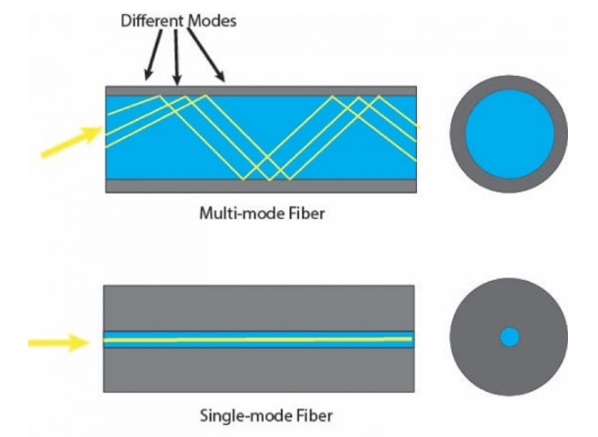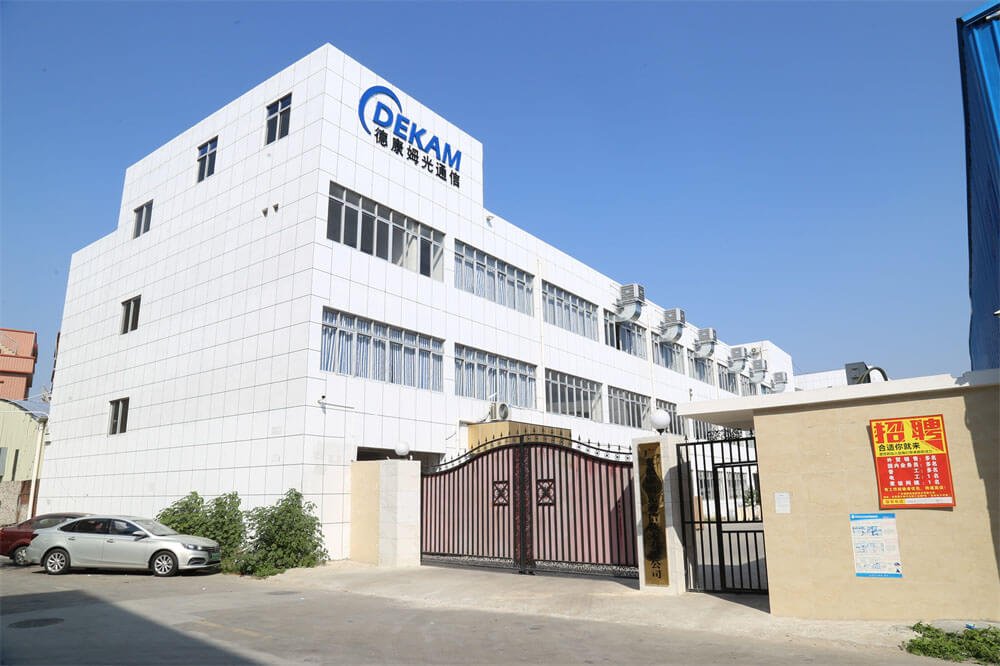Fiber optic cables are a revolutionary invention in the communication field. The great thing about them is that they consist of very fine glass wires as opposed to traditional copper wires. Thus, they transmit data as light, resulting in increased speed and efficiency during communication.
Do remember whether you are IT manger, or business owner of telecom companies, whenever you want to purchase fiber optic cables, it is common that two important types will be presented: single-mode and multimode fiber. Understanding the differences assists you in choosing the most appropriate type for you. So, keep reading this article!

1) Single mode vs. Multimode fiber: Basic overview
i) What is single-mode fiber?
“Single-mode fiber is a kind of optical fiber cable that has a core of 9 micrometers in size, thus enabling light to propagate in only one straight direction.”
It employs laser light, which propagates uninterruptedly through the cable, keeping your information swift and reliable over long distances. If you are designing a network that has the potential to extend across cities, a nation, or even parts of the world, then this is the choice that you are looking for. Clear!
i) What is multimode fiber?
“Multimode fiber is a type of optical fiber that is often 50-62.5 micro-metres in diameter and thus enables a bigger number of light rays to be transmitted through distinct paths.”
Unlike laser, multimode fiber has LEDs which are cheaper but not very effective. But if your arrangement is in a single location and doesn’t require long distance capabilities, then multimode fiber is quite economical.

2) Comparison between single-mode and multimode fiber
Hopefully, now you will be a bit familiar with these two terms. Now, let’s have a look at the key differences between single-mode and mulit-mode fiber optics cable, so you can make informed decisions according to your needs and requirements. So, stay tuned!
i) Core Size and Light Transmission: Single mode vs multimode fiber
- A single-mode fiber possesses a core( middle potion of cable usually made up of glass or plastic ) of 9µm which is remarkably narrow and allows light to pass through it in one straight line. Thus, ensuring minimum disruption and maximum visibility, especially over great distances.
- Multi-mode fiber has much wider core measurements of about 62.5 µm and this method allows light to travel across various modes. As a result light reaches to end of cable at different times. This however cause disturbances in the signal’s quality as lighting fibers get scattered across the cable.
Outcome: In conclusion, for maintaining high signal quality over great distances, single-mode fiber offers the ideal solution. On the other hand, if aiming for short distances, multi-mode fibers are perfect.
ii) Distance capability: Multimode vs single-mode fiber
As far as distance limits are concerned, both single-mode and multimode fiber cables serve different purposes. For example,
- Single mode fiber: Its function is to transfer data over a long distance where active transmission typically occurs over a span of over 40 kilometres, or up to a 100 km with the use of signal amplifiers.
- Multimode fiber works quite well under a span of up to 500 meters especially if used with high-speed transfers such as 10 Gbps. However, if a higher transfer rate is desired such as 40 Gbps or 100 Gbps then the range drastically decreases.
Outcome: Thus, while building a long-range network you would most likely be interested in single-mode fiber. However, if you are working with link-local networks or need transfer speed within a limited distance, multimode fiber is the better option.
iii) Bandwidth: Single mode vs multimode fiber
Bandwidth can be described as the maximum transmission capacity of a network within a specified time interval. In most cases, it is calculated in bits transmitted for each second. If the bandwidth is wide, the transmission or transfer of information such as files, videos etc. will be relatively quick and unwavering.
- Single-mode fiber has an almost unlimited carrying capacity furthermore allowing for future applications to come through.
- Multimode fiber allows transmission of high speeds over shorter distances. It has very limited bandwidth over long distances due to signal deterioration.
Outcome: If you need scalability and faster speed for years to come, go with single-mode. Multimode is great for immediate, short-term needs.
iv) Cost Considerations: Multimode vs single-mode fiber
- Single-mode fiber cables are cheap but the lasers and precise installation they need can be pricey which increases the overall cost. On top of that, the specialized installation itself increases the labour cost leading to expensive overall costs with regard to large-scale projects.
- Multimode fiber: But it’s a different story with multimode fiber as it has cheaper cables and equipment such as LEDs alongside a simpler installation process leading to reduced labor costs.
Outcome: Thus, if you’re working on a large-scale setup that’s also going to take a long time then single-mode fiber is a sound investment because scalability is the goal and single-mode fibers are ideal for that. But if scalability isn’t the case and you have a smaller budget then multimode fiber would be the better fitting option.
v) Applications: Single mode vs multimode fiber
- Applications of Single Mode fiber
? Telecommunications: Single-mode fiber optic cable is vital in long-distance communication networks with high-speed data transfer around the world including cities or between countries.
? Internet Providers: Single-mode fiber is used by the ISPs for fast internet services over large coverage areas with little signal deterioration to high distances.
? High-reliability settings: For MP services, including stock exchange operations, single-mode fiber ensures true real-time data that is prompt, dependable, and devoid of any interference, this ensures that data is genuine at all times.
? Large Scale Data Centers: Single-mode fiber provides reliable, long-distance links to servers, storage, and networks in big data centres for wide-area fast communication within massive structures.
? Corporate and Campus Networks: Many corporate offices or university buildings on a single campus are easily interconnected using single-mode fiber at a greater speed and are less likely to malfunction.
- Applications of Multimode fiber
? Local Area Networks (LANs): A building or a small campus is best served with this type of cable network. Whenever devices have to be centrally connected and this type of fiber can transmit data at greater speeds at about 500 meters.
? Data Centers: Within data centres, multimode fiber cables are laid to connect servers to switches while at short distances to achieve high data transfer at lower costs.
? Campus network interconnections: Multimode fiber optics are often used for interconnecting buildings, especially in the campus network for the purpose of communication in a corporate or educational institution.
- Summary Table: Single Mode vs Multimode Fiber
| Feature | Single mode Fiber | Multimode fiber |
| Core Size | ~9 µm | 50 µm or 62.5 µm |
| Light Transmission | Single light wave | Multiple light paths |
| Distance Capability | Up to100 km | Up to 500 m |
| Bandwidth | Virtually unlimited | Limited to short range |
| Speed | 100 Gbps+ (long range) | 10-40 Gbps (short range |
| Cost | Higher equipment cost | Lower overall cost |
3) Final Verdict: Which One is Right for You?
In a nutshell, I must say that what suits you best between a single mode and a multimode fiber greatly depends on your requirements. To facilitate your decision-making process, here is a quick summary:
- In the case where your network is expected to span across larger distances, for example, buildings or cities or even different continents, then single-mode fiber is the optimal choice. Its cost-effectiveness in terms of speed, bandwidth and reliability, justifies the increased upfront cost.
- When connecting devices positioned in relatively close range like a single building, campus or even a data center, using a multimode fiber is a more cost-effective solution.
Because fiber optics are future technology, buying the right type today will ensure that you receive optimal performance and value for many years to come. We offer only the highest quality customized fiber optics cables including both indoor and outdoor fiber optic cable that enable you to fulfil your requirements. Our fiber optic cables are copper free and are nor electrically charged. So, request an instant quote today!




